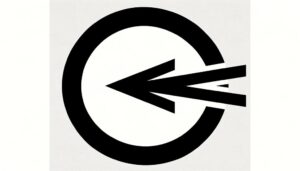Understanding Car Dashboard Symbols: Step-by-Step Meanings
Understanding car dashboard symbols is crucial for maintaining your vehicle's safety and performance. The Check Engine Light indicates engine malfunctions like faulty oxygen sensors.
A Battery Alert suggests charging system problems such as a failing alternator. The Oil Pressure Warning signals critical lubrication issues that require immediate action.
A Tire Pressure Indicator warns of tire pressure deviations affecting safety and efficiency. The Brake System Warning denotes potential brake issues needing urgent inspection.
A Coolant Temperature Alert warns against overheating, and an Airbag Indicator highlights airbag system malfunctions. Learn more about these symbols to keep your car in top condition.
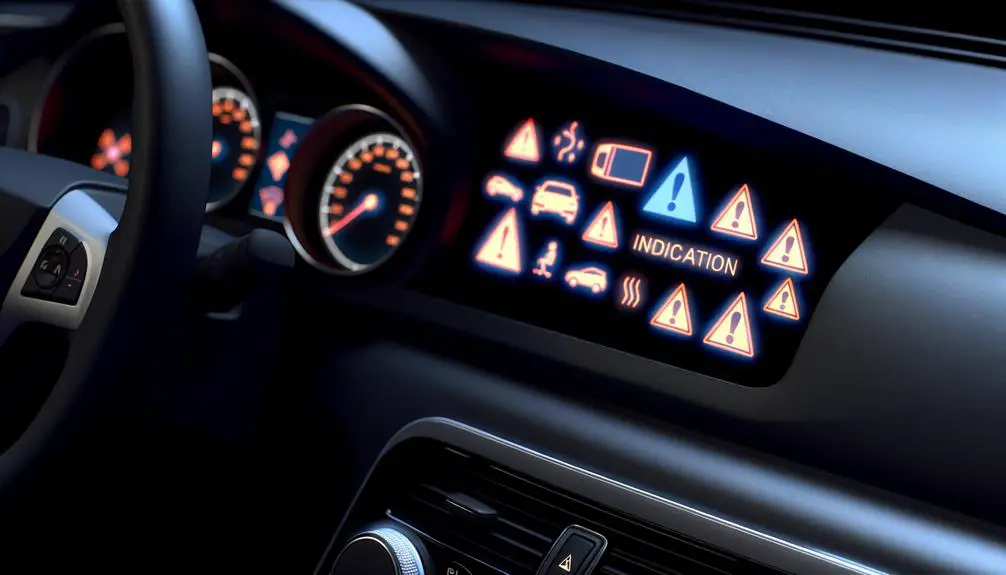
Key Takeaways
- The Check Engine Light signals detected engine malfunctions, requiring diagnostic code reader or OBD-II scanner for accurate diagnosis.
- Battery Alert indicates a charging system issue, often due to a failing alternator or corroded battery terminals.
- Oil Pressure Warning highlights a critical engine lubrication problem, necessitating immediate action to prevent severe engine damage.
- Tire Pressure Indicator warns of tire pressure outside the recommended range, affecting safety and fuel efficiency.
- Airbag Indicator signals a potential issue with the airbag system, requiring prompt attention to ensure passenger safety.
Check Engine Light
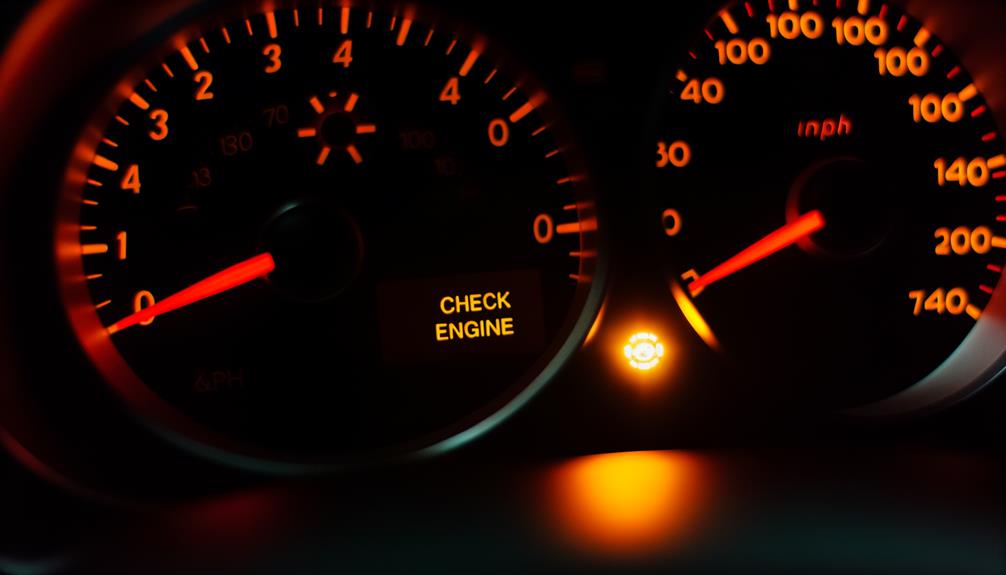
When the check engine light illuminates on your dashboard, it indicates that the vehicle's onboard diagnostics system has detected a malfunction or anomaly within the engine or its related components. This warning alert could result from various issues, including faulty oxygen sensors, catalytic converter malfunctions, mass airflow sensor failures, or even a loose gas cap. Immediate attention to this signal is essential, as neglecting it can lead to more severe mechanical problems and decreased fuel efficiency.
To diagnose the exact issue, a diagnostic code reader or an OBD-II scanner is typically employed. These tools retrieve error codes that pinpoint the specific malfunction, allowing for precise and efficient repair. Understanding these codes and addressing them promptly ensures peak vehicle performance and longevity.
Battery Alert
In addition to the check engine light, the battery alert on your dashboard indicates a problem with the vehicle's charging system. This issue could be caused by a failing alternator, corroded battery terminals, or a deteriorated battery.
This warning is vital as it signifies that the battery is not receiving adequate charge, potentially leading to a complete electrical system failure. Immediate attention is required to diagnose and resolve the underlying issue.
Technicians typically begin by testing the battery and alternator, followed by inspecting connections and wiring for corrosion or damage. Early intervention can prevent more severe complications, such as engine stalling or starting difficulties, ensuring the reliability and safety of your vehicle's electrical systems.
Oil Pressure Warning
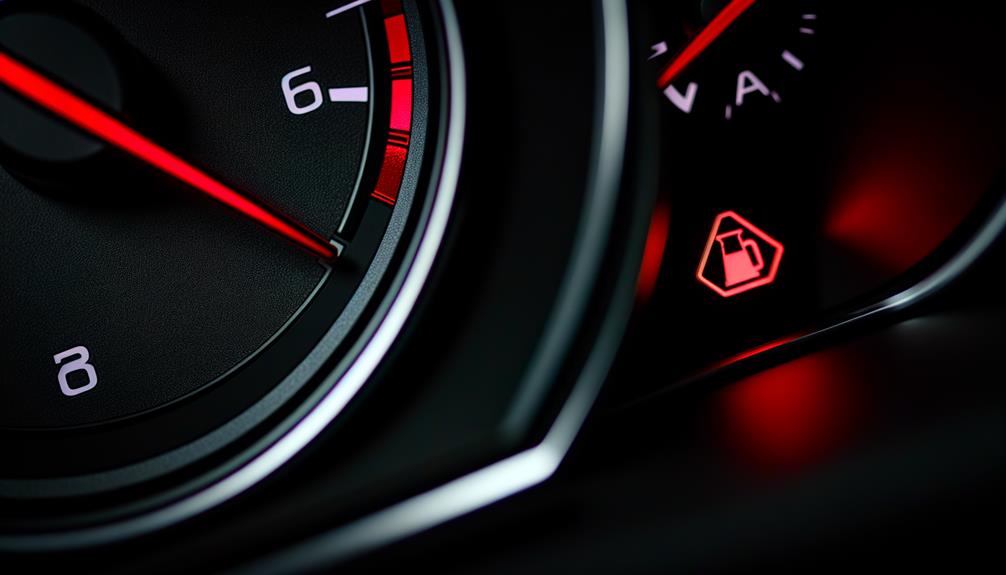
The oil pressure warning light indicates a critical issue with the engine's lubrication system. This could be caused by low oil levels, a failing oil pump, or clogged oil passages. The warning light, usually represented by an oil can symbol, signals that the engine may not be receiving sufficient lubrication.
Insufficient lubrication can lead to increased friction and heat, which can cause severe engine damage. Immediate action is crucial: stop the vehicle as soon as safely possible and check the oil level. If the oil level is adequate, the problem might be with the oil pump or oil passages.
Prolonged operation with this warning light illuminated can result in catastrophic engine failure. This could lead to costly repairs or even engine replacement.
Tire Pressure Indicator
A tire pressure indicator light signals that the vehicle's tire pressure is outside the recommended range, potentially impacting safety and fuel efficiency. This warning light, typically resembling an exclamation mark inside a horseshoe, activates when the Tire Pressure Monitoring System (TPMS) detects an imbalance.
Insufficient tire pressure can lead to reduced traction, increased tire wear, and decreased fuel economy. Conversely, overinflated tires can compromise ride comfort and handling. Ensuring tire pressure is within manufacturer specifications is essential.
Drivers should check tire pressure with a reliable gauge and adjust accordingly. Regular maintenance and prompt attention to the tire pressure indicator can prevent undue wear and enhance overall vehicle performance.
Brake System Warning
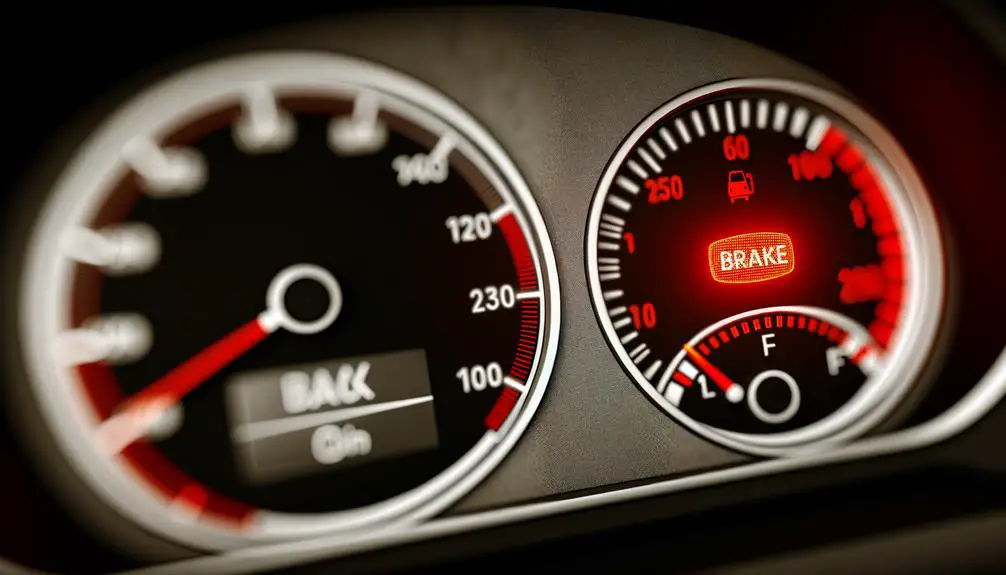
The Brake System Warning light is a vital indicator on your dashboard that signals potential issues such as low brake fluid, worn brake pads, or a malfunctioning ABS system.
Immediate actions include checking brake fluid levels and making sure the parking brake is fully released.
For thorough diagnosis and repairs, professional inspection is crucial to guarantee vehicle safety and performance.
Common Warning Signs
When the brake system warning light illuminates on your car's dashboard, it indicates a potential issue with the braking system that requires immediate attention.
This warning light, typically represented by an exclamation mark inside a circle or the word 'BRAKE,' points to various issues such as low brake fluid levels, worn brake pads, or a malfunction in the brake system itself. Additionally, it may signal a problem with the anti-lock braking system (ABS) if the ABS light is also illuminated.
Recognizing this warning sign is essential for maintaining vehicle safety, as the braking system is fundamental to controlling and stopping the vehicle effectively. Understanding these indicators helps in diagnosing the issue accurately before it escalates into a more severe problem.
Immediate Actions Required
Prompt and decisive action is essential upon noticing the brake system warning light to guarantee vehicle safety and functionality.
When this indicator illuminates, immediately cease driving and safely pull over to the side of the road.
Inspect the brake fluid level; a low level could indicate a leak or worn brake pads. Refill with the appropriate brake fluid if necessary.
If the brake pedal feels soft or spongy, or if there is a noticeable decrease in braking efficiency, do not continue driving. Engage the parking brake and call for roadside assistance.
Ignoring this warning can result in brake failure, posing serious risks not only to the driver but also to other road users.
Professional Inspection Needed
In cases where the brake system warning light persists despite initial checks and actions, a thorough professional examination is crucial to identify and address underlying issues.
Persistent brake alerts may indicate critical issues such as brake fluid leaks, worn brake pads, or malfunctioning brake calipers. Skilled technicians utilize specialized diagnostic tools to evaluate brake system health thoroughly. They inspect components including the master cylinder, ABS modules, and brake lines to guarantee efficient functionality.
Ignoring this warning can compromise vehicle safety, leading to brake failure and accidents. It is essential to seek immediate professional assessment to preserve the integrity of the braking system and maintain safe driving conditions.
Coolant Temperature Alert
The Coolant Temperature Alert on your dashboard indicates that the engine may be overheating, which can result from several factors such as low coolant levels, a malfunctioning thermostat, or a failing water pump.
Immediate actions required include safely stopping the vehicle, turning off the engine, and allowing it to cool before checking the coolant level or seeking professional assistance.
Ignoring this warning can lead to severe engine damage and costly repairs.
Causes of Overheating
Several factors can contribute to the overheating of a vehicle, often indicated by the coolant temperature alert on the dashboard. Insufficient coolant levels are a primary cause, as coolant is essential for heat dissipation.
A malfunctioning thermostat, which regulates coolant flow, can also lead to overheating. Blockages in the radiator or coolant passages impede proper heat exchange, exacerbating the issue. Additionally, a damaged water pump can fail to circulate coolant effectively.
External factors, such as extreme ambient temperatures and heavy towing, place additional stress on the cooling system. Finally, a failing radiator fan can hinder airflow, preventing adequate cooling.
Each of these conditions disrupts the efficient operation of the engine's cooling system, triggering the alert.
Immediate Actions Required
When the coolant temperature alert illuminates on your dashboard, immediate action is imperative to prevent severe engine damage. First, safely pull over and turn off the engine to allow it to cool.
Check the coolant level in the reservoir; if it is low, add the appropriate type of coolant after the engine has sufficiently cooled. Avoid opening the radiator cap while the engine is hot to prevent burns from escaping steam.
Inspect for visible leaks, damaged hoses, or a malfunctioning radiator fan. If the problem persists, contact a professional mechanic for a thorough diagnosis and repair. Ignoring the coolant temperature alert can lead to catastrophic engine failure and costly repairs.
Airbag Indicator

Signaling a potential issue with the airbag system, the airbag indicator light on your dashboard warrants immediate attention to guarantee passenger safety. This symbol typically appears as a silhouette of a seated person with a circle in front, representing the airbag. When illuminated, it may suggest a malfunction within the airbag system, which could compromise its deployment in an accident.
Key aspects to ponder include:
- System Diagnostics: The car's onboard diagnostics should be checked immediately.
- Professional Inspection: A certified technician should assess the airbag system for faults.
- Potential Faults: Issues may range from faulty sensors to wiring problems.
- Safety Risk: Ignoring this light could result in the airbag failing to deploy during a collision.
Understanding these points ensures proactive safety measures.
Conclusion
Ironically, the modern vehicle, designed for convenience and safety, communicates its most critical issues through a series of indecipherable symbols. The check engine light, battery alert, oil pressure warning, tire pressure indicator, brake system warning, coolant temperature alert, and airbag indicator each demand attention to prevent potential hazards.
Consequently, while technology advances, it paradoxically complicates the driver's ability to swiftly interpret and address urgent mechanical concerns, underscoring an age-old reliance on human vigilance and technical acumen.





